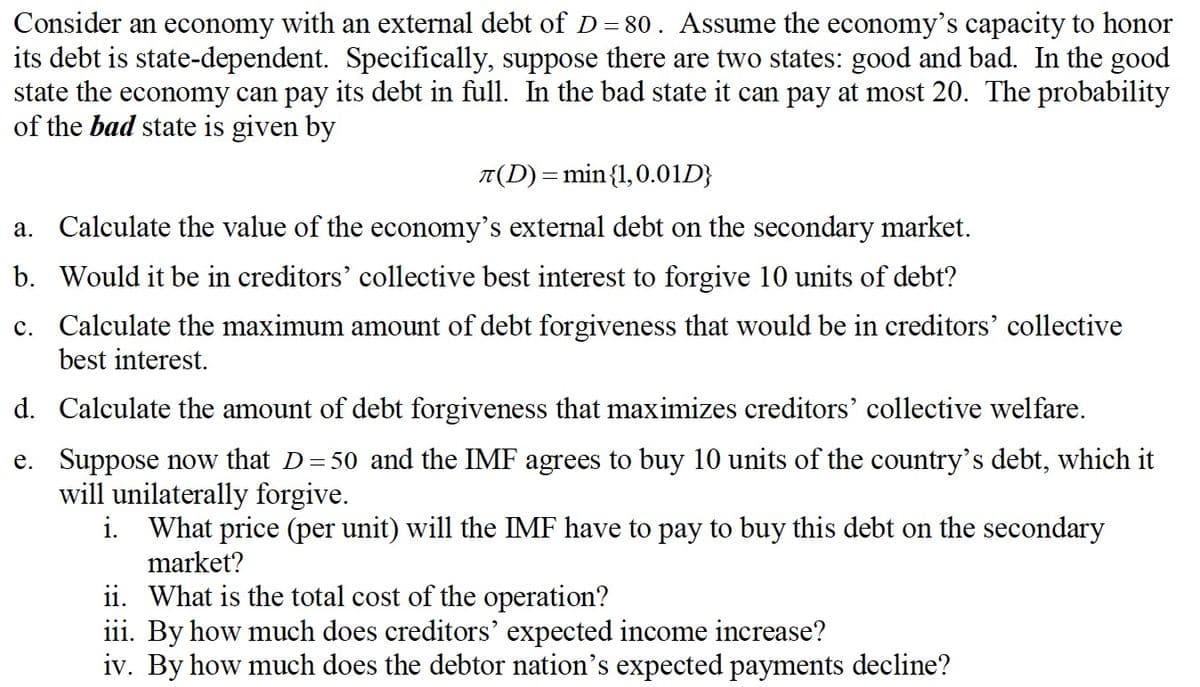Consider an economy with an external debt of D=80. Assume the economy's capacity to honor its debt is state-dependent. Specifically, suppose there are two states: good and bad. In the good state the economy can pay its debt in full. In the bad state it can pay at most 20. The probability of the bad state is given by 7(D)= min {1,0.01D} a. Calculate the value of the economy's external debt on the secondary market. b. Would it be in creditors' collective best interest to forgive 10 units of debt? c. Calculate the maximum amount of debt forgiveness that would be in creditors' collective best interest.
Consider an economy with an external debt of D=80. Assume the economy's capacity to honor its debt is state-dependent. Specifically, suppose there are two states: good and bad. In the good state the economy can pay its debt in full. In the bad state it can pay at most 20. The probability of the bad state is given by 7(D)= min {1,0.01D} a. Calculate the value of the economy's external debt on the secondary market. b. Would it be in creditors' collective best interest to forgive 10 units of debt? c. Calculate the maximum amount of debt forgiveness that would be in creditors' collective best interest.
Chapter11: Fiscal Policy And The Federal Budget
Section: Chapter Questions
Problem 16QP
Related questions
Question

Transcribed Image Text:Consider an economy with an external debt of D = 80. Assume the economy's capacity to honor
its debt is state-dependent. Specifically, suppose there are two states: good and bad. In the good
state the economy can pay its debt in full. In the bad state it can pay at most 20. The probability
of the bad state is given by
T(D) = min {1,0.01D}
a. Calculate the value of the economy's external debt on the secondary market.
b. Would it be in creditors' collective best interest to forgive 10 units of debt?
c. Calculate the maximum amount of debt forgiveness that would be in creditors' collective
best interest.
d.
Calculate the amount of debt forgiveness that maximizes creditors' collective welfare.
e. Suppose now that D=50 and the IMF agrees to buy 10 units of the country's debt, which it
will unilaterally forgive.
i. What price (per unit) will the IMF have to pay to buy this debt on the secondary
market?
ii. What is the total cost of the operation?
iii. By how much does creditors' expected income increase?
iv. By how much does the debtor nation's expected payments decline?
Expert Solution
This question has been solved!
Explore an expertly crafted, step-by-step solution for a thorough understanding of key concepts.
Step by step
Solved in 6 steps

Follow-up Questions
Read through expert solutions to related follow-up questions below.
Follow-up Question
For question b, the new expected repayment is 35, which is 3 units more than the original expected repayment, 32. Isn't the answer Yes? It should be in the best interest.
Solution
Knowledge Booster
Learn more about
Need a deep-dive on the concept behind this application? Look no further. Learn more about this topic, economics and related others by exploring similar questions and additional content below.Recommended textbooks for you


Economics (MindTap Course List)
Economics
ISBN:
9781337617383
Author:
Roger A. Arnold
Publisher:
Cengage Learning


Economics (MindTap Course List)
Economics
ISBN:
9781337617383
Author:
Roger A. Arnold
Publisher:
Cengage Learning